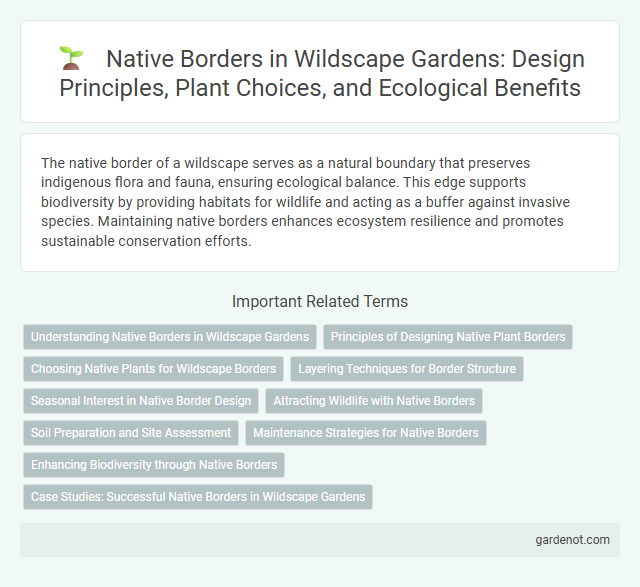The native border of a wildscape serves as a natural boundary that preserves indigenous flora and fauna, ensuring ecological balance. This edge supports biodiversity by providing habitats for wildlife and acting as a buffer against invasive species. Maintaining native borders enhances ecosystem resilience and promotes sustainable conservation efforts.
Understanding Native Borders in Wildscape Gardens
Native borders in Wildscape Gardens consist of carefully selected indigenous plants that create sustainable habitat edges, supporting local wildlife and enhancing biodiversity. These borders mimic natural ecosystems, promoting ecological balance by providing food, shelter, and migration pathways for native species. Incorporating native border plants improves soil health and water retention, reinforcing the garden's environmental resilience.
Principles of Designing Native Plant Borders
Designing native plant borders emphasizes ecological harmony by selecting species adapted to local soil, climate, and wildlife needs. Incorporating diverse native grasses, wildflowers, and shrubs fosters habitat connectivity and supports pollinators, enhancing biodiversity. Proper spacing and layering ensure plant health and aesthetic appeal while minimizing invasive species disruption.
Choosing Native Plants for Wildscape Borders
Selecting native plants for wildscape borders enhances local biodiversity and supports pollinators by providing essential food and habitat. Species such as Echinacea purpurea, Asclepias tuberosa, and Rudbeckia hirta thrive in native soil conditions and require less water and maintenance compared to non-native alternatives. Incorporating a diverse mix of native grasses, flowering perennials, and shrubs ensures year-round interest and ecological balance.
Layering Techniques for Border Structure
Wildscape native borders benefit from layering techniques that combine diverse plant heights and textures to create dynamic visual interest and ecological benefits. Utilizing grasses, perennials, and shrubs in staggered arrangements enhances habitat complexity, supporting pollinators and wildlife. Strategic layering also improves soil health and moisture retention, promoting long-term resilience in the border structure.
Seasonal Interest in Native Border Design
Seasonal interest in native border design is achieved by incorporating a diverse mix of perennial grasses, flowering shrubs, and native wildflowers that each peak at different times throughout the year. Plants such as Echinacea purpurea bloom in summer, while Symphyotrichum novae-angliae adds vibrant colors in fall, and evergreen species like Ilex glabra provide structure and visual appeal during winter. This deliberate layering ensures continuous texture, color, and wildlife habitat, enhancing the dynamic beauty of a native border across all seasons.
Attracting Wildlife with Native Borders
Native borders planted with indigenous grasses, wildflowers, and shrubs create vital habitats that attract a diverse range of wildlife, including pollinators, birds, and small mammals. These borders enhance local biodiversity by providing food sources and shelter, fostering natural ecosystems within urban and suburban landscapes. Strategic use of native plants in border design supports ecological balance and promotes sustainable wildlife corridors.
Soil Preparation and Site Assessment
Soil preparation and site assessment are critical for establishing a successful native border in a wildscape. Proper soil testing ensures optimal pH levels and nutrient balance, promoting native plant health and biodiversity. Evaluating site conditions such as sunlight, drainage, and existing vegetation allows for selecting suitable native species that thrive in the local ecosystem.
Maintenance Strategies for Native Borders
Effective maintenance strategies for native borders in Wildscape emphasize regular monitoring to preserve plant health and prevent invasive species encroachment. Utilizing native plant species promotes ecosystem stability and supports local wildlife habitats, reducing erosion and improving soil quality. Integrating adaptive management techniques ensures resilience against environmental changes while maintaining the ecological balance of native borders.
Enhancing Biodiversity through Native Borders
Native borders play a crucial role in enhancing biodiversity by providing essential habitats for local flora and fauna, promoting ecological balance within wildscapes. These borders support pollinators, birds, and small mammals by offering food sources and shelter, which increases species diversity and ecosystem resilience. Incorporating native plant species in border design helps restore natural landscapes and improves soil health, further contributing to a thriving and sustainable wildscape environment.
Case Studies: Successful Native Borders in Wildscape Gardens
Case studies of successful native borders in Wildscape gardens demonstrate the effective use of indigenous plants to create sustainable and ecologically balanced environments. These borders enhance biodiversity by supporting local wildlife such as pollinators and birds while reducing maintenance needs through natural growth patterns. Incorporating native species like wildflowers, grasses, and shrubs fosters resilience to climate variations and promotes healthy soil ecosystems within Wildscape landscapes.
Native border Infographic

 gardenot.com
gardenot.com